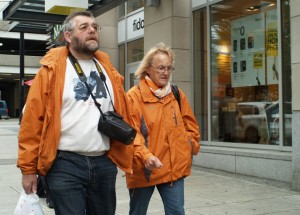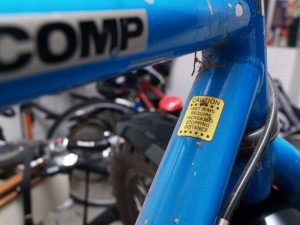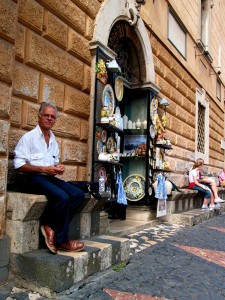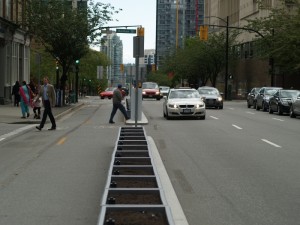Wet Rims Take Longer
For some reason, my old mountain bike had this terribly quaint warning sticker on the down-tube where you can’t see it while you’re riding. I’ve always wondered two things about that:
1. Of all the things that can cause trouble while you’re riding a bike, how did their committee of lawyers choose that, and only that, hazard?
2. Why did they warn me with a sticker I can’t see when I’m riding?
New Cell phone update
So, further to my reports of life without out a cell phone (here & here), I got myself a phone with Wind at the end of June. Despite many reports on forums of narrow home-calling areas and many drop-outs, I’m finding it works just swell. Except: the home zone doesn’t extend into my office! The phone goes into Away zone whenever it sits on my desk. I gots to say, that’s very annoying. It’s in home zone for much of the rest of the library. It even stays in home zone if I hang it from a hook on the wall of my office (seriously!). But I keep forgetting it when I do that. Â Luckily, my N810 connects to my voip account in my office so I’m still reachable. And the new cell forwards to the old voip but I haven’t quite worked out the best call-forwarding settings yet so, the cell phone saga continues.
Why we can’t learn from Italy to fix our broken neighbourhood designs.
I was reading La Bella Figura about how piazza’s are the centre of Italian public life and realized that there’s no where to go from our neighbourhood that’s part of my urban life. Will construction on Fraser street (at 39th or at 30th) help? Am I dreaming to think it would? And even if it’s something useful there, a cafe that people gather at, it’s going to be on a busy street. It’s not that piazza’s are always quiet, they aren’t. They can also be clogged with cars. But they’re in the *centre* of the community. Our neighbourhood quandrants that are bounded by arterials mean that the gathering places are at the edges of the neighbourhood: on the arterials. This is an inherent problem, I’d say.
One step in a long journey
We opened a new separated bike lane on a downtown street. It’s a start.
I realize it looks totally unused to motorists but it’s a necessary first step: we won’t attract cyclists until we have infrastructure because of safety perception.
I suspect this is not how car usage grew. Motorists don’t feel unsafe around other road users so they will try using a route as soon as they see it’s avaailabe and then they’ll complain because it’s slow and congested.
The difference is that potential cyclists *won’t* try a route if they think it’s the slightest bit unsafe but instead complain that it’s not safe.
We have to be willing to build (some) infrastructure and then exhort/market to citizenry to use this capacity.
Of course, this leaves us open to criticism from right-wing car addicts/lobby that we’re spending money on infrastructure for nobody (or for latte-sipping urban lefties, or whomever). I’m optimistic this time that our civic politicians have the ability to withstand this criticism.
Finally, we’re making progress in this town.
We’re finally making some progress and getting better at defining and maintaining bicycle infrastructure. Our bike routes, especially  in the central areas of the city, are highly problematic because of short-cut SOV traffic. I complained about this before. Now something’s going to be done to fix Ontario St. Maybe I can start riding it again without getting bummed-out.
The problem with the IOC (in brief)
I’ve decided that we can distill the definition of the problem with the IOC down to one person: Prince Hubertus.
I know that what’s wrong with the IOC can fill (and has already filled) several books but I say that if you want the short course, look no further than Prince Hubertus of Hohenlohe-Langenburg: a European aristocrat playing ski racer (and “pop singer”, no less).
Oh, I know Hubertus himself is not a member of the IOC. But just look at the list of IOC members. Look at the members representing European countries. Some of them don’t even have names, just titles. They probably don’t have any idea what that looks like to us over here in this part of the world.
What big events can do for us.
There’s been a lot of talk in these parts about how damaging and disastrous the Olympics are shaping up to be. Most of this talk seems to really be centred on the immediate problems of traffic, road closures, security threats (real and imagined), cost, and so on. Holding the Olympics here required us to make a deal with an organization who’s ideas about democaracy and civic participation are, to be polite, considerably different than our own. I think the only way to tell whether the Olympics will really be worth it is to look at the whole idea of this kind of big event and what we can get out of it in the long term.
I grew up here in Vancouver before Expo 86 and I’ve learned some things about our economy, urban culture, and civic social life since then and how they differ between the late 70’s/early 80’s and now.
Vancouver was a very provincial city well into the 1980’s. Historically, the wealth we created was sent away in the form of profits for outside interests who controlled our economy. These interests were sometimes European but usually from Montreal and Toronto. You can contrast this with Chicago. Chicago is not much older than Vancouver but it was much more the centre of its own economy and therefore the wealth generated there stayed there. If you ever travel to Chicago, it shows. The art and architecture are both examples of a city that was able to, to some extent set the terms for its own future.
Vancouver culture and social life was a curious mix of old time pioneer excess and the constricted mores of the Presbetyrians who ran the place for most of the 20th century. While we had some successful cultural phases (mid-century modern architecture and late 70’s punk are two that come to mind), none of them were enough to create our own urban culture or change our economic or cultural position within Canada.
After Expo 86 we began to see ourselves as a post-industrial metropolis and we had some ‘world-city’ currency to capitalize on it. Although some of our most significant land and housing development since then has been carried out by national and international development countries, we’ve been able to dictate, at least to some extent, the form of that development in a way that helps us achieve some of the goals we’ve set for ourselves. “World city” is a misunderstood term but there is a reasonable stable academic understanding of it. By most measures, Vancouver is a 3rd tier world city. We’ll never be New York or Tokyo (1st tier) or even as important as Toronto (2nd) but expo 86 allowed us to be visible to others around the world on our own terms, not based on what Upper Canada thought we should be or be seen as.
Big events let us create an image of ourselves that we can purvey to outsiders. We can use a big event to define ourselves to the rest of the world. Image and perception are, in some ways, quite important. They are a way to tell people around the world what we think and what we stand for. These messages are not short term but are something we define over longer periods of time as we mature. These are not necessarily commercial messages, either. Both the short-term irritation of the Olympics (and having to deal with the authoritarian IOC) and the mid-term hassle of financing the Olympics (assuming the doom & gloom debt predictions are true) could well be worth the cost if we are able to use the attention and opportunity of this event to continue to build our own urban culture and economy in a way that we think works best for us.
This opportunity to communicate what we think our city is to the rest of the world is critical to Vancouver because we can not rely on our own nation to communicate our message our way. Essentialy, we never get an even break from our nation or the cultural & economic “empire” we live in if we rely on them to communicate to the world about us. The message will always be delivered on their terms and from their perspective. Canada’s messages to the world are intrinsically linked to Toronto’s vision of itself as Canada’s Primate City and any message they send about the rest of the country is conflicted by that vision. In addition, we are, an odd outpost on the edge of the American cultural and economic “empire” and their messages about us continually seem to reflect that.
Even the original history of British Columbia and Vancouver Island reflects this conflicted and inaccurate National imagery. The Hudson Bay Company (the original colonizer of Vancouver Island), under the Governorship of James Douglas was a surprisingly progressive entity that seemed to respect and, in some ways, promote the diversity of the early inhabitants (both colonial and native). This history is nothing like that of the colonialists who took over central and eastern canada and yet “national” histories of British Columbia do not seem to understand or convey this fact.
One obvious example of what can be acheived when we are able to disseminate our image of ourselves to the world is the ‘Vancouver model” of urban development which was the result of the aforementioned land and housing development carried out by international companies who were willing to adhere to, at the time, unique requirements for urban development in North America.
In the future, we may look at the current campaign to make Vancouver the “Greenest City” as another example of this successful city-building. Only time will tell if this will have the same impact as “Vancouverism” or whether it will be something else that comes along in the next few years.
There is one last, very important, reason that we need a big event to help us communicate with the world. Our “Vancouver Experiment” in urban development isn’t finished and we need continue to travel our own path to solve the remaining problems.
The basic North American land-development model is based on cheap land and a low overall metropolitan population. The result is a housing system based on single-family dwellings and a transportation system based on the private car. We’re at a mid-point in the evolution to a better urban model which should make us a better city for the future. Our better urban model should help us withstand the end of oil, allow us to build an inclusive, safe, peaceful urban culture, and attract economic activity that lets us pay the bills. But we’re suffering from the fact that we’re not finished. We don’t yet have enough well-functioning urban neighbourhoods so housing is way too expensive. We aren’t the most expensive city in the continent but our current housing stock isn’t sufficient with these current land values. We need to continue to “urbanize” our inner suburbs (which includes much of the City of Vancouver) so that there is housing and community for all. Our Metropolitan population itself is now too large for our low overall housing density so our transportation system doesn’t function properly. This is exacerbated by our land characteristics (our buildable land is hemmed-in by water, mountains, and the border) so relying on car travel from the suburbs creates too many choke points and the suburban density does not support mass transit.
We have to keep going to make sure that the benefits of ‘Vancouverism’ are available to everyone who’s here and the only way we’ve been able so far to do that is to get our message out to the rest of the world so that we can ensure that our terms of engagement with the rest of the world, whether cultural, economic, or social, are based on our values.
New cell phone setback
As I reported last post: I was expecting that I’ll have to eventually get a new phone contract to allow the family the perception that they are in constant (potential) contact with me.
However, I’ve reached a temporary setback.
We have a FIDO “couples” plan. But only one phone on it at the moment because I removed my old phone last summer. But I didn’t change the plan because I wanted be able to add a phone back on to it. And so I called them and asked to do that.
Not so fast. To add a phone to this “existing” couples plan, that has only one phone on it, triggers a new 2-year contract. I’ve been a FIDO customer for 9 years. I don’t owe them any 2-year-contract. Ever again. But, says the customer rep, you can change the existing plan to a “legacy” single-number plan (with no fixed term contract) and add a new no-contract phone (as a separate account, I assume). But then we lose the pooled minutes and the legacy plan has too many minutes on the wrong phone. I told the nice pleasant customer-service rep that if I have to start new plans or new 2-year-contracts it triggers the necessity for me to research the other phone providers (including new ones coming this year) because I can’t assume that what Fido is forcing me to change to would be best for me. She told me I’ll have to do that homework.
Damn. Looks like I’m back to square one. Ever since Rogers bought Fido, my phone company has been an obstacle who acts like they’re out to screw me.
No Cell Phone: Update
At the end of December I bought a Nokia N810 on Ebay. Among other things, it’s perfectly set up as a wifi-voip mobile phone. I’m getting used to saying “call me at xxxxxxxx”, then having people say, “oh, you have a new cell phone”, and I say, “it’s not really a phone but you can call me and when I’m in a wifi zone, I’ll call you back.”
Some people are intrigued and ask me more about it, but some people really don’t get it. The whole “not a phone but you can call me” is just too weird, I guess.
Anyway, it’s turning out to be very useful but one of the values of a cell phone (that family can call at any moment and have, in their minds, a reasonable expectation that I’ll answer) is a little bit lost on them. The fact of the matter is, however, that when they phoned while I was on my way home from work I wouldn’t likely hear or be able to reach my phone and it would go to message anyway.
That said, it’s pretty much a given that I’ll get a phone too, at some point in the near future. I’m just hoping not to give out the cell number to anyone but those who really have to use it (re: family).



